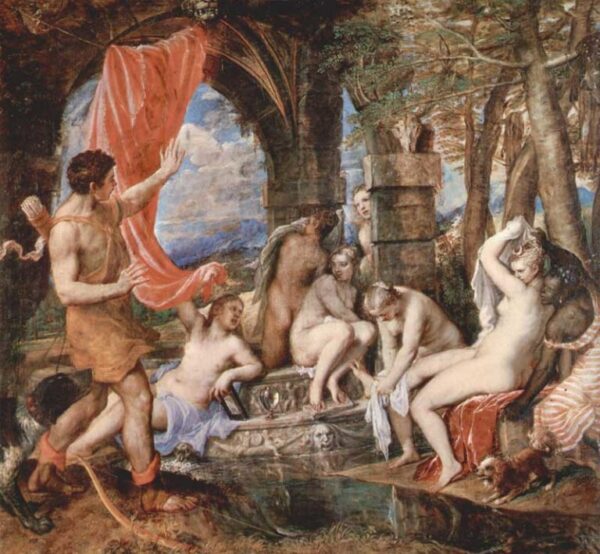Artemis – Diana
by Ignazio Caloggero
Origins of the Myth
According to Greek mythology, Artemide, identified with Italian Diana of the Romans, she is considered the daughter of Zeus and the twin sister of Apollo. Like her brother, she is armed with a bow and loves hunting; however, while Apollo is seen as the personification of the sun, Artemis is seen as the personification of the moon, in fact, he is often represented with his inseparable bow while hunting at night, by torchlight.
In her hunting trips she was often accompanied by beautiful nymphs, and woe to those who dared to attack their virtues: the hunter Orion was, in fact, killed for trying to rape some of his companions.
Mortals weren't even allowed to see Artemis naked, another hunter, named Actaeon, who, having seen the naked goddess, was first transformed into a deer and then mauled by his own dogs.
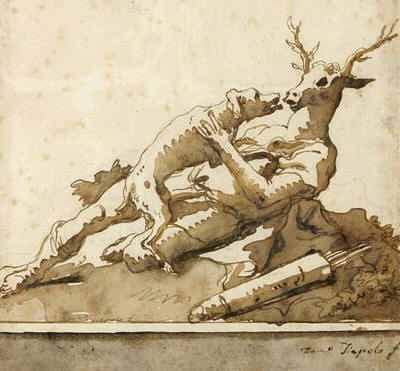 Domenico Tiepolo (Venice 1727 - 1804) Metamorphosis of Actaeon
Domenico Tiepolo (Venice 1727 - 1804) Metamorphosis of Actaeon
Like the Phoenician god Baal, Artemis once had to receive human sacrifices. It is known, in fact, that in the city of Ephesus in Lydia (Asia Minor) where the temple of Artemis was set on fire in 356 BC, the goddess depicted with numerous breasts was venerated as a symbol of fertility and to whom, in ancient times, human victims were sacrificed.
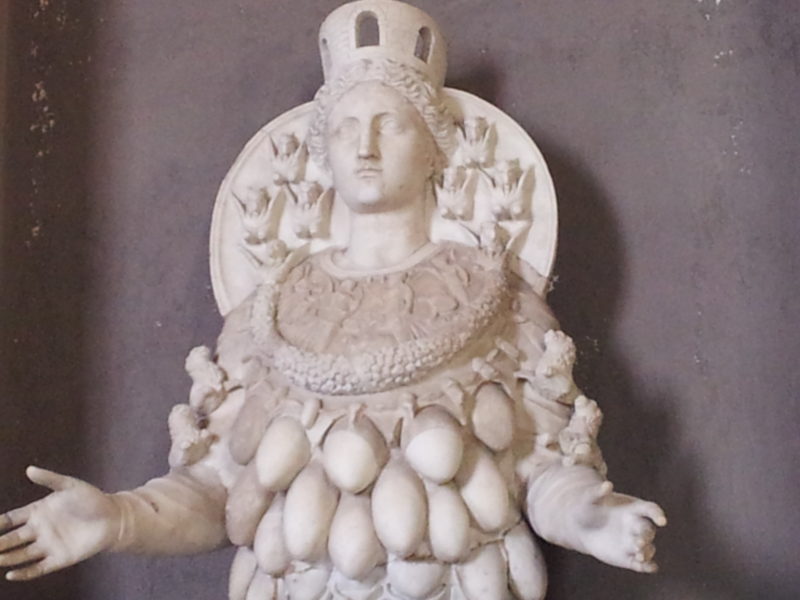 Artemis of Ephesus, Vatican Museums
Artemis of Ephesus, Vatican Museums
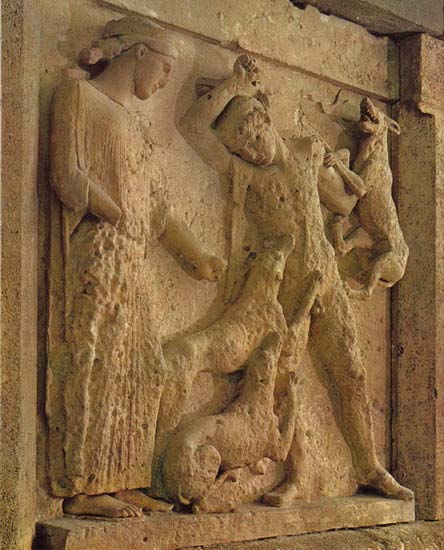 Actaeon mauled by dogs and Artemis
Actaeon mauled by dogs and Artemis
In Attica and in Sparta, human sacrifices were performed in his honor which were later abolished, even if in Sparta, every year during his feast, some children were whipped to death [Felice Ramorino: Classical Mythology p. 62]. Traces of human sacrifices can also be seen in the story according to which the hero Agamemnon, while waiting for the right moment to leave with his fleet against Troy, killed a deer during a hunt and, seized by euphoria, let out the exclamation "Artemis herself could not have killed him like this". Artemis, hurt by the sentence, raised a calm that immobilized the fleet. A soothsayer revealed the cause of the calm adding that the only solution was to sacrifice to the goddess Ifigenia, the king's virgin daughter. The sacrifice was arranged but Artemis, moved with pity, replaced, at the last moment, a fawn for the young woman, who she kidnapped and transported to the distant land of Tauride in the Black Sea (Crimea), where she made her a priestess of a temple dedicated to her. It is probable that the story wants to highlight the departure from human sacrifices by freeing him from the oriental influence of the cult.
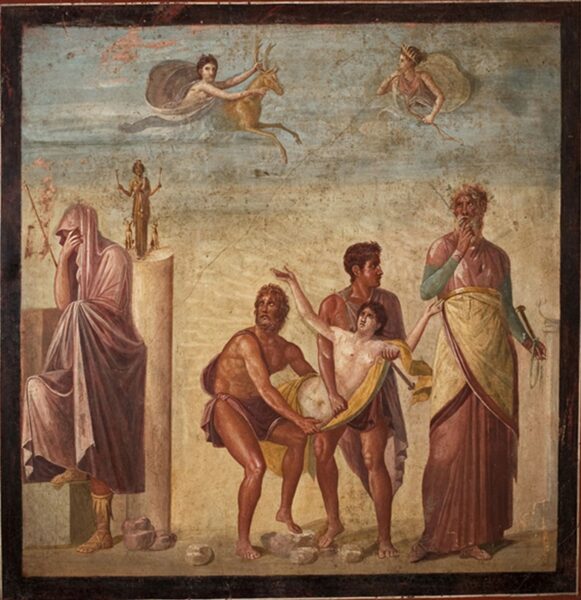
Fresco depicting the Sacrifice of Iphigenia House of the Tragic Poet, Pompeii
The departure from human sacrifices and their replacement with animal ones can be found in the festivals that took the name of Lafrie, in honor of Artemis Lafria, during which domestic and wild animals were sacrificed at the stake.
There was also no lack of parties with an orgiastic character, similar to those of Dionysus: like the Ephesians, which took place in Athens at night.
The Cult of Artemis in Sicily
In Sicily the cult of Artemis was particularly widespread; we talk about it to Agrigento, Alesia, Centuripe, Leontini, Murganzia and also in one of the three ible of Sicily: that of Etna. Ciaceri recounts that in Centuripe (35 km north-west of Catania), hanging from the skeleton of a girl's head, closed in a lead case, a clay medallion representing Artemis was found [Ciaceri Emanuele: Culti e Miti of Ancient Sicily p. 174]. According to some versions of the myth Artemis went to the island of Lipari (Aeolian Islands), where the forge of the Cyclops was located to obtain the weapons he needed (a bow, quiver and arrows). The forge of the Cyclops is also located, in other versions and myths, under Etna
SIRACUSA
The cult of this goddess was particularly flourishing in Syracuse, on the island of Ortigia, where her temple stood near that of Athena [Diodoro Siculo lib. V.3], with whom she had affinities: both, in fact, had been Persephone's companions. Diodorus tells us that Athena and Artemis made, as Persephone had done, the choice to remain virgins, and, therefore, were raised together with her. It is no coincidence that the cult of Artemis in Syracuse is linked to that of Demeter and Persephone. Indeed, Artemis is seen by Pausanias as the daughter of Demeter; others, however, consider her the daughter of Persephone.
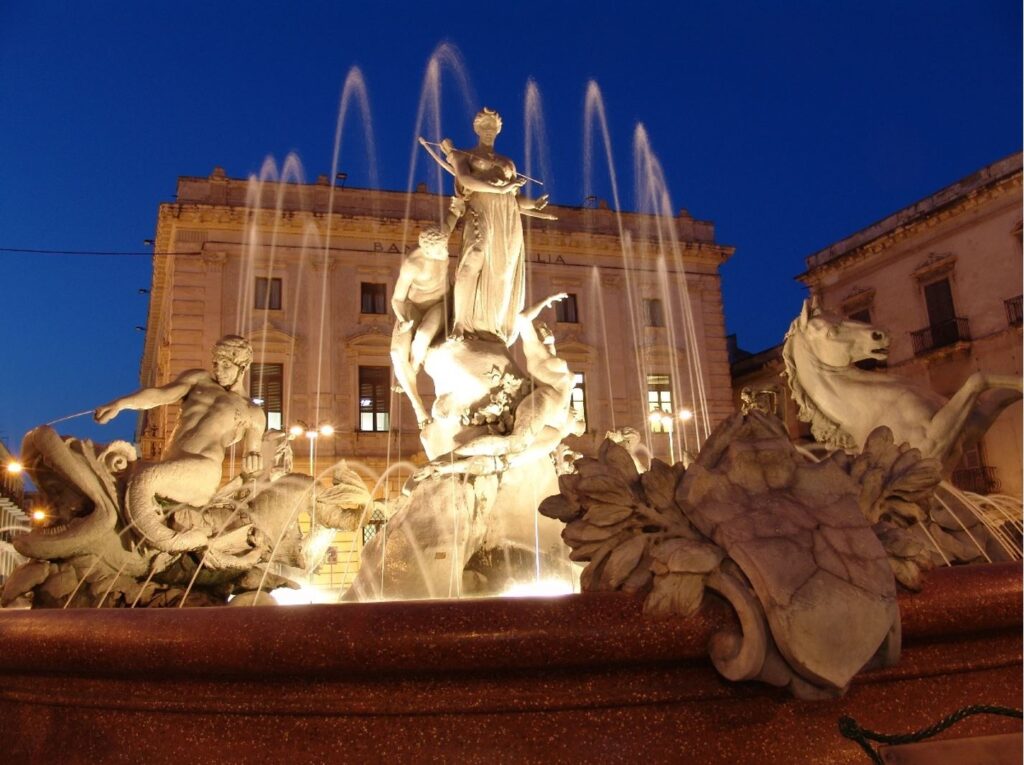
Syracuse – Fountain of Artemis (Photo: Ignazio Caloggero)
Selinunte
The presence of the cult in Selinunte would be demonstrated by the discovery of a metope depicting the goddess.
Camarina
In Camarina, the cult of the goddess would be demonstrated by the discovery of some votive statuettes dedicated to the divinity, some of these are now kept in the archaeological museum of Ragusa.
Segesta
In Segesta the cult of Artemis must have been particularly flourishing, as can be deduced from the reading of Cicero (Verrine II. IV. 72-80), who describes a bronze statue depicting Diana present in the city and its abduction by Verres, Roman governor of Sicily from 73 to 71 BC Cicero recounts that, among the Segestans, there was a bronze statue of Diana, "surrounded by a very particular veneration that dated back to very ancient times, moreover masterfully executed in a truly original style and with extraordinary skill ”.
Segesta was destroyed and sacked by the Carthaginians who took away the statue. After the capture of Carthage by Publius Scipio, during the Third Punic War, the statue was returned to the Segestans who rearranged it in the ancient site, on a pedestal on which the name of Publius Scipio was carved, in memory of the return of the statue .
“The statue was of considerable proportions and of considerable height, with a long cloak. And yet even in that majesty, the age and bearing of a virgin transpired. From her shoulder hung her arrows, in her left hand he held the bow, in her right hand he held out a burning torch ”.
Verre ordered the Segestani to remove the statue and deliver it to him; their refusal was punished with a series of oppressions which, in the end, forced the population of Segesta to submit to the will of Verre and approve a contract for the removal of the statue. However, no Segestan, free or slave, dared to touch the statue to remove it; to solve the problem, some non-Greek workers had to be called from Marsala who, amidst the pain and consternation of the Segestani, removed the statue.
“while Diana was being taken out of the city, all the women of Segesta, both married and single, ran over, sprinkled her with perfumed ointments, covered her with wreaths of flowers, escorted her to the borders of their territory by burning incense and fragrant essences".
Religious syncretism
The arrival of Christianity sees Artemis first confused with the same demon driving the witches at night [Carlo Pascal: Gods and devils in dying paganism. p. 88], then with the Madonna; not by chance, according to tradition, the virgin Mary would have lived the last years of her life in Ephesus, site of the famous temple of Artemis, previously mentioned [Ambrogio Donini: Breve storia delle religioni. p. 138].
The Myth in the IWB Register of the Sicily Region
The places of the myth of Artemis – Diana have been included in the regional map of places and identity and memory (Places of myth and legends). Even if the recognition of the Sicilian Region is limited only to the places of Syracuse and the Aeolian Islands
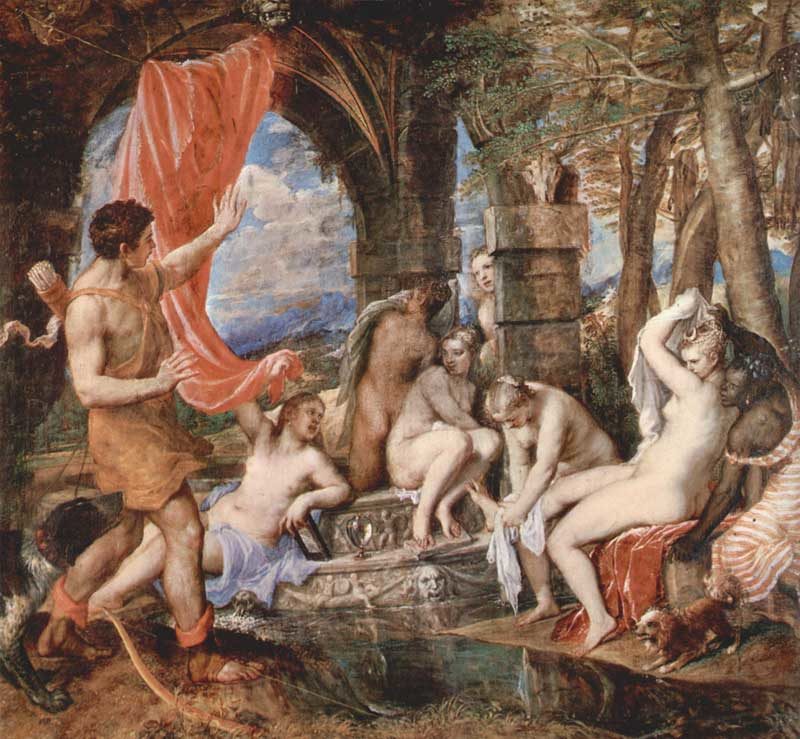 Diana and Atteone Titian (1556-1559)
Diana and Atteone Titian (1556-1559)
To visualize the places of the Myth, including those included in the IWB, on the Interactive Map, see the following web page: The places of Artemis (Diana)
Extract from the Book ” Cults of Ancient Sicily” by Ignazio Caloggero ISBN: 9788832060102 © 2022 Centro Studi Helios srl


